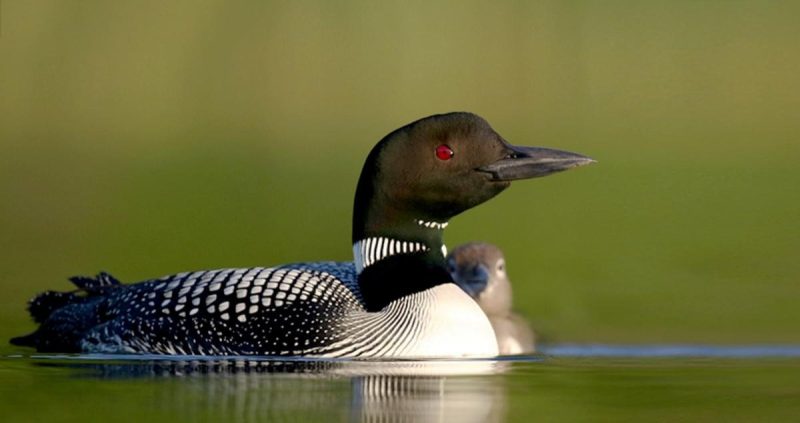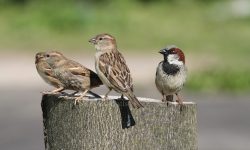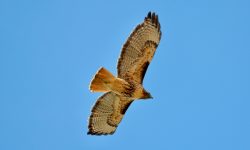Introduction: The Haunting Call of the North
Echoing across the mirror-like surfaces of Michigan’s northern lakes, the eerie, flute-like calls of the Common Loon (Gavia immer) are as much a part of the landscape as the pines and glacial waters themselves. These birds, with their distinctive black-and-white plumage and red eyes, are not just fascinating biological specimens but icons of the wild northern wilderness. In Michigan, especially in the Upper Peninsula and northern Lower Peninsula, Common Loons serve as both biological treasures and environmental indicators, capturing the imagination of birdwatchers, ecologists, and tourists alike.

Meet the Common Loon
Physical Features and Identification
Sleek, striking, and unmistakably wild, the Common Loon is a living emblem of Michigan’s northern waters. Its elegant form glides effortlessly across the surface, cloaked in a dramatic checkerboard of black and white. The breeding adult is a vision of contrast: a shimmering black head with greenish iridescence, a sharply pointed, dagger-like bill, and intense crimson eyes that gleam like embers against the twilight of a northern lake. In winter, their plumage softens to silvery-gray, but their sleek silhouette remains unmistakable. Built for an aquatic life, loons ride low in the water like living torpedoes. Their legs, positioned far to the rear of their bodies, give them unrivaled diving power—yet render them awkward, almost helpless, when on land.
Behavior: Solitary Divers and Haunting Voices
Few birds evoke the spirit of the wild like the Common Loon. These solitary swimmers are typically seen alone or in tight-knit breeding pairs, silently slicing through the still waters of secluded lakes. But it is their voice that truly defines them. Their eerie, echoing calls—yodels that stake a male’s claim to territory, tremolos that tremble with unease, and long, melancholic wails that span miles—form an acoustic portrait of solitude and wilderness. Heard at dusk or beneath a moonlit sky, a loon’s call stirs something primal in the human heart, weaving them into the mythology of the north as both sentinel and songster of Michigan’s remote lakes.
Life in Michigan’s Lakes
Where to Spot Loons in Michigan
With its endless mosaic of shimmering inland lakes and the mighty sweep of the Great Lakes shoreline, Michigan offers a paradise for loons. These deep-diving birds thrive where the waters are clear, quiet, and rich with fish—conditions abundant across the state’s northern reaches. Regions like Cheboygan, Alpena, and Marquette are well-known strongholds, where the haunting calls of loons echo across dawn-lit waters and still evenings. From late April through October, when the ice recedes and the lakes awaken, loons return in force. Kayakers, birders, and lakefront residents alike often catch glimpses of their sleek forms gliding low in the water or hear their wild cries piercing the misty morning air.
Seasonal Presence and Breeding Habits
Each spring, as the last of the snow retreats and the ice melts from northern lakes, loons journey back from coastal wintering grounds to reclaim their nesting territories. Often loyal to the same lake year after year, mated pairs arrive in synchrony, reuniting with uncanny precision. Their nests—shallow platforms built from reeds and grasses—rest precariously at the water’s edge, where any rise in water level or careless disturbance can prove disastrous. Yet this proximity to the lake is vital: it allows the newly hatched chicks to slip straight into the water, avoiding the awkward, near-impossible trek over land.
Typically, loons lay one or two speckled eggs in late May or early June. Within a few hours of hatching, the downy chicks are already paddling beside their parents, sometimes hitching rides on their backs for warmth and safety. For several weeks, they depend entirely on the adults for food—tiny fish passed delicately from beak to beak—until they gain enough strength and skill to dive on their own. This intimate family choreography, played out against a backdrop of pine forests and pristine waters, defines the Michigan summer as much as the call of the loon itself.
The Art of Diving: Loons as Underwater Hunters
How Loons Dive and Hunt
Beneath the tranquil surface of Michigan’s northern lakes, the Common Loon transforms from graceful glider to stealthy predator. Built like torpedoes with feathers, loons are among nature’s most accomplished divers—capable of plunging over 200 feet beneath the surface in pursuit of prey. Once submerged, they become silent shadows, slicing through the water with astonishing speed and control.
Unlike most birds, loons possess solid bones, a rare adaptation that adds weight and helps them sink quickly. Their powerful, rear-placed legs act like twin propellers, driving them forward with surgical precision. Using their sharp, spear-like bills, they can snatch fish in rapid strikes, often changing direction mid-dive with the agility of an underwater acrobat. Watching a loon vanish silently below the surface, only to reappear a minute later with a wriggling catch, is to witness a marvel of avian evolution at work.
What They Eat in Freshwater Habitats
In Michigan’s cool, fish-filled waters, loons find a banquet waiting below. Their diet centers on small fish—yellow perch, bluegills, sunfish, and shimmering schools of minnows—all of which provide the high-protein fuel needed for their demanding lifestyle. But loons are opportunistic hunters, and they’ll also go after crayfish, leeches, and even aquatic insect larvae like dragonflies when fish are scarce.
Vision is their most vital hunting tool. Loons rely entirely on sight to detect and pursue their quarry, making clear, unpolluted water essential to their survival. In fact, water clarity can determine where loons choose to feed or raise their young. Murky or sediment-filled lakes can mean missed meals—and, for hungry chicks, a threat to survival. In this way, loons serve as living indicators of water quality, their presence a quiet testament to the health of Michigan’s freshwater ecosystems.
The Common Loon as a Symbol of Northern Wilderness
Cultural and Ecological Significance
To many, the Common Loon is not just a bird—it is the very voice of the wild. Its haunting call drifting across a still lake at twilight evokes something timeless and sacred, a sound that seems to echo from an age before roads or cities. For centuries, Indigenous peoples across North America have revered the loon. In Ojibwe and other Native American traditions, the loon often appears as a spiritual guide, a bringer of messages, or even a creator figure whose cry connects this world to the next.
Today, the loon remains a powerful symbol—this time of conservation and wilderness. Its striking appearance, otherworldly voice, and intimate connection to clean water have made it a flagship species for environmental causes. The bird is a frequent subject in nature writing, poetry, and art, representing purity, solitude, and resilience. In Michigan, the presence of a loon on a quiet lake signals something rare and beautiful: a place still ruled by nature, where the balance between human and wild has not yet been lost.
Loons in Michigan Folklore and Tourism
Every summer, travelers venture north through pine forests and winding lake roads in hopes of encountering a loon. Whether paddling a kayak at dawn or watching from the porch of a lakeside cabin, Michiganders and visitors alike feel a quiet thrill at the sight of a loon pair gliding in the mist or feeding their fuzzy chicks beneath the reeds.
The loon has become an unofficial ambassador of Michigan’s northern identity. Its image adorns rustic signs, fine art prints, and hand-carved souvenirs sold in lake towns from Petoskey to Marquette. Birding festivals, such as the Tawas Point Birding Festival, often celebrate the loon as one of the season’s highlights, drawing enthusiasts from across the country. These experiences are more than just tourism—they create lasting memories and cultivate a love for the land. In this way, the Common Loon doesn’t just symbolize the wild north—it helps keep it alive, in both economy and spirit.
Conservation Outlook
Mercury Pollution and Human Disturbance
For all their resilience and grace, Common Loons are far from invincible. Beneath the serene surface of Michigan’s lakes lurk threats that are invisible, insidious, and deadly. Chief among them is mercury pollution—a legacy of coal-fired power plants and industrial emissions that settles into the water and builds up in fish, the loon’s primary food source. When loons consume contaminated prey, mercury enters their bodies and interferes with the most vital systems: impairing coordination, disrupting behavior, and most tragically, causing reproductive failure. A lake may appear pristine, but to a loon, it may be laced with unseen danger.
Beyond chemical threats, loons face growing pressure from human activity. Shoreline development replaces wild coves with manicured lawns and docks. High-speed boats send waves crashing over fragile nests. Sudden changes in water levels, sometimes from dam operations or heavy rains, can flood shoreline nests before the chicks ever see daylight. In a world growing louder, busier, and less predictable, loons—so deeply tied to calm, clean waters—find themselves increasingly on the edge.
State Programs and Citizen Science
Yet hope floats alongside concern. Across Michigan, dedicated conservationists, scientists, and volunteers are working to ensure that the call of the loon will echo across northern lakes for generations to come. One of the most effective efforts is the Michigan LoonWatch program, which mobilizes citizens to monitor nesting pairs, report threats, and protect vulnerable sites. These local “loon guardians” are often the first line of defense, helping preserve nests and educate lakefront communities about how to coexist with these sensitive birds.
Policy changes have followed science’s lead. Restrictions on lead-based fishing tackle—once a major source of poisoning for loons that accidentally ingested lost sinkers—have reduced toxic exposure. Habitat protection measures are being enacted around key breeding lakes, and water recreation guidelines increasingly consider the needs of nesting birds. Through public education, festivals, and outreach, more people are learning not just how to spot a loon—but how to protect one.
Today, the Common Loon is officially listed as a “Threatened” species in Michigan. That designation, while sobering, has brought much-needed attention and legal protection during the crucial breeding months. And thanks to decades of effort, loon populations have shown signs of slow recovery. Each chick that hatches, each pair that returns to the same lake, is a quiet success—proof that with care and commitment, the wild can still endure.
Conclusion: Guardians of the Great Lakes’ Silence
Common Loons are an irreplaceable part of Michigan’s natural heritage, embodying the silence, mystery, and resilience of northern lakes. Their presence is not only a testament to ecological health but also a call for continued stewardship. As climate change and pollution challenge their habitat, the haunting call of the loon becomes both a beautiful sound of wilderness and a powerful reminder of what we must protect. For Michigan residents and visitors alike, to see or hear a loon is to connect with the wild, to witness a master of the deep, and to cherish the lakes that define the Great Lakes State.






